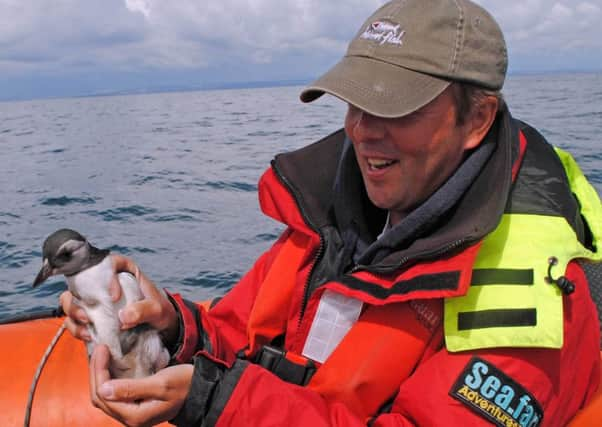Seabird Centre guide saves lost puffling


Puffins and their young are now leaving their burrows on the islands of Craigleith, Fidra and the Isle of May in the Forth and heading out to sea.
But some pufflings become disorientated by the lights of North Berwick and look for somewhere dark to hide in the town to escape from predators such as gulls.
Advertisement
Hide AdAdvertisement
Hide AdAs puffling season gets under way, the Scottish Seabird Centre in the East Lothian town has already been called on to rescue two of the birds and help them back out to sea.
Phil the puffling was found hiding for safety beneath a car on the town’s High Street on July 19 after a member of staff from the centre spotted him and called the Scottish SPCA.
After being carefully coaxed into a long net, he made it safely back out to sea on a rigid inflatable boat manned by Seabird Centre guide James Leyden.
The following week, on Monday, residents Sandra and Ronnie Williams were alerted to a puffling in their garden in the town by their dog, Alfie.
They kept the bird – later named Polly – in a box overnight in their garage before handing her over to the centre the next day when she was taken back out to sea.
Mrs Williams said: “We realised it was a puffling and so managed to catch it and kept it safe overnight in a box in the garage.
“We phoned the Seabird Centre the following morning and took it down there where staff looked after Polly until it was time to head back out to sea.”
The public is now being asked to keep an eye out under cars and in gardens for any pufflings who have gone astray.
Advertisement
Hide AdAdvertisement
Hide AdTom Brock, Scottish Seabird Centre chief executive, said: “It is a crucial time in the puffin season and we want to ensure as many as possible of these wonderful seabirds make it out to sea.
“Pufflings look very different from their colourful parents – they are shades of grey, white and black, their smaller beaks don’t have the characteristic bright colours that the adults have in summer.
“Both puffins and pufflings can be killed and eaten by gulls, which we are also keen to avoid.”
“If we can rescue and release as many pufflings as possible, we can look forward to seeing them in future years from our boat trips and on our live cameras when they themselves return to breed on the local islands.”
There are around 5500 apparently occupied puffin burrows on Craigleith and around 55,000 around the Firth of Forth, with two adults and one puffling for each successful burrow nest.
May saw the annual Puffin Fest at the Scottish Seabird Centre, which brought together a host of family-friendly and educational events ranging from trips on the Puffin Express out to the island of Craigleith, to photography workshops and puffin puppet shows.